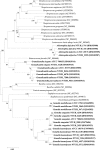Use of groESL as a target for identification of Abiotrophia, Granulicatella, and Gemella species
- PMID: 20686088
- PMCID: PMC2953133
- DOI: 10.1128/JCM.00787-10
Use of groESL as a target for identification of Abiotrophia, Granulicatella, and Gemella species
Abstract
We determined the groESL sequences of three species of nutritionally variant streptococci (Abiotrophia defectiva, Granulicatella adiacens, and Granulicatella elegans) and three Gemella species (Gemella morbillorum, Gemella haemolysans, and Gemella sanguinis). The nucleotide sequence similarities between the groES and groEL genes of the above genera were 41.7 to 85.9% and 63.7 to 84.3%, respectively. The intraspecies similarities of groESL sequences for the isolates of Abiotrophia and Granulicatella species were 94.4 to 97.8% for groES and 94.0 to 98.2% for groEL. For Ge. morbillorum and Ge. sanguinis, all strains showed the same groESL spacer length (8 bp), and sequence identities within species were >97.8% for groES and >96.1% for groEL. However, higher intraspecies heterogeneity was observed in Ge. haemolysans. Phylogenetic analysis of groEL sequences separated the 6 isolates of Ge. haemolysans into two subgroups. Among these isolates, three isolates with the same groESL spacer region length (45 bp) clustered together but were distant from the ATCC reference strain (with a spacer length of 8 bp). The remaining three isolates, with a spacer length of 50 or 8 bp, clustered together. Although 16S rRNA gene sequence analysis did not provide enough discrimination for the 6 Ge. haemolysans isolates, rpoB gene sequence analysis supported the subgrouping. Based on the obtained groESL sequences, we developed a multiplex PCR that enables simple, rapid, and accurate identification of Abiotrophia, Granulicatella, and Gemella at the genus level. This assay would be helpful for identifying these fastidious and slow-growing organisms in clinical laboratories.
Figures


Similar articles
-
Genetic heterogeneities and phenotypic characteristics of strains of the genus Abiotrophia and proposal of Abiotrophia para-adiacens sp. nov.J Clin Microbiol. 2000 Feb;38(2):492-8. doi: 10.1128/JCM.38.2.492-498.2000. J Clin Microbiol. 2000. PMID: 10655334 Free PMC article.
-
Antimicrobial Susceptibilities of Abiotrophia defectiva, Granulicatella adiacens, and Granulicatella elegans.Antimicrob Agents Chemother. 2015 Dec 14;60(3):1411-20. doi: 10.1128/AAC.02645-15. Antimicrob Agents Chemother. 2015. PMID: 26666926 Free PMC article.
-
Comparison of MALDI-TOF MS and VITEK 2 system for laboratory diagnosis of Granulicatella and Abiotrophia species causing invasive infections.Diagn Microbiol Infect Dis. 2013 Nov;77(3):216-9. doi: 10.1016/j.diagmicrobio.2013.07.008. Epub 2013 Sep 10. Diagn Microbiol Infect Dis. 2013. PMID: 24034902
-
Infective endocarditis due to Abiotrophia defectiva and Granulicatella spp. complicated by infectious intracranial cerebral aneurysms: a report of three cases and review of the literature.J Med Microbiol. 2016 Jun;65(6):493-499. doi: 10.1099/jmm.0.000260. Epub 2016 Apr 5. J Med Microbiol. 2016. PMID: 27046228 Review.
-
Empyema due to Gemella morbillorum Is Diagnosed by 16S Ribosomal RNA Gene Sequencing and a Phylogenetic Tree Analysis: A Case Report and Literature Review.Intern Med. 2015;54(17):2231-4. doi: 10.2169/internalmedicine.54.4950. Epub 2015 Sep 1. Intern Med. 2015. PMID: 26328652 Review.
Cited by
-
Antimicrobial Susceptibility to 27 Drugs and the Molecular Mechanisms of Macrolide, Tetracycline, and Quinolone Resistance in Gemella sp.Antibiotics (Basel). 2023 Oct 14;12(10):1538. doi: 10.3390/antibiotics12101538. Antibiotics (Basel). 2023. PMID: 37887239 Free PMC article.
-
Use of tuf as a target for sequence-based identification of Gram-positive cocci of the genus Enterococcus, Streptococcus, coagulase-negative Staphylococcus, and Lactococcus.Ann Clin Microbiol Antimicrob. 2012 Nov 27;11:31. doi: 10.1186/1476-0711-11-31. Ann Clin Microbiol Antimicrob. 2012. PMID: 23181410 Free PMC article.
-
leBIBIQBPP: a set of databases and a webtool for automatic phylogenetic analysis of prokaryotic sequences.BMC Bioinformatics. 2015 Aug 12;16(1):251. doi: 10.1186/s12859-015-0692-z. BMC Bioinformatics. 2015. PMID: 26264559 Free PMC article.
-
The Versatility of Opportunistic Infections Caused by Gemella Isolates Is Supported by the Carriage of Virulence Factors From Multiple Origins.Front Microbiol. 2020 Mar 31;11:524. doi: 10.3389/fmicb.2020.00524. eCollection 2020. Front Microbiol. 2020. PMID: 32296407 Free PMC article.
-
Secretome analysis and virulence assessment in Abiotrophia defectiva.J Oral Microbiol. 2024 Feb 12;16(1):2307067. doi: 10.1080/20002297.2024.2307067. eCollection 2024. J Oral Microbiol. 2024. PMID: 38352067 Free PMC article.
References
-
- Chen, H. J., J. C. Tsai, T. C. Chang, W. C. Hung, S. P. Tseng, P. R. Hsueh, and L. J. Teng. 2008. PCR-RFLP assay for species and subspecies differentiation of the Streptococcus bovis group based on groESL sequences. J. Med. Microbiol. 57:432-438. - PubMed
-
- Durack, D. T., E. L. Kaplan, and A. L. Bisno. 1983. Apparent failures of endocarditis prophylaxis. Analysis of 52 cases submitted to a national registry. JAMA 250:2318-2322. - PubMed
Publication types
MeSH terms
Substances
Associated data
- Actions
- Actions
- Actions
- Actions
- Actions
- Actions
- Actions
- Actions
- Actions
- Actions
LinkOut - more resources
Full Text Sources
Molecular Biology Databases
Research Materials

